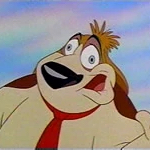 Earlier this year I did a week of rock ’n roll related animated features, including Don Bluth’s ROCK-A-DOODLE, which was released on August 2, 1991 in the U.K. (though not until the following April in the U.S.). In that review I talked about Disney struggling in the ‘80s, and Bluth disagreeing with their direction and splintering off to try to recapture the old Walt magic, doing a pretty good job for a while but then completely losing the plot by that time, when he made that completely befuddling movie about a farm rooster exiled to animal Las Vegas.
Earlier this year I did a week of rock ’n roll related animated features, including Don Bluth’s ROCK-A-DOODLE, which was released on August 2, 1991 in the U.K. (though not until the following April in the U.S.). In that review I talked about Disney struggling in the ‘80s, and Bluth disagreeing with their direction and splintering off to try to recapture the old Walt magic, doing a pretty good job for a while but then completely losing the plot by that time, when he made that completely befuddling movie about a farm rooster exiled to animal Las Vegas.
 Meanwhile, Disney was finally getting their shit together, in a way that reinvigorated the entire American animation industry. It kicked off in the summer of ’88, when Robert Zemeckis and Richard Williams’ love letter to animation history WHO FRAMED ROGER RABBIT was a giant hit with adults as much as kids. Then in ’89 THE LITTLE MERMAID perfected the musical fairy tale formula that Disney and its rivals would attempt to recapture for the rest of the decade. (A similar thing was happening on TV, with every network trying to make prime time cartoons in the wake of The Simpsons. Even the cartoons made for younger audiences were beginning to be more creative and less disposable: Nickelodeon debuted Doug, Rugrats and The Ren & Stimpy Show on August 11th.)
Meanwhile, Disney was finally getting their shit together, in a way that reinvigorated the entire American animation industry. It kicked off in the summer of ’88, when Robert Zemeckis and Richard Williams’ love letter to animation history WHO FRAMED ROGER RABBIT was a giant hit with adults as much as kids. Then in ’89 THE LITTLE MERMAID perfected the musical fairy tale formula that Disney and its rivals would attempt to recapture for the rest of the decade. (A similar thing was happening on TV, with every network trying to make prime time cartoons in the wake of The Simpsons. Even the cartoons made for younger audiences were beginning to be more creative and less disposable: Nickelodeon debuted Doug, Rugrats and The Ren & Stimpy Show on August 11th.)
I personally think Disney’s main 1990 release THE RESCUERS DOWN UNDER is one of the best of that era, but at the time everybody wanted a musical, and it was considered a flop. In ’91 they turned that around with BEAUTY AND THE BEAST, which would earn a historic best picture nomination, cementing the newly elevated status of animated features in American pop culture. They achieved that partly by releasing it in November, which left them room on the schedule to re-releases one of “WALT DISNEY’S CLASSIC”s in the summer.
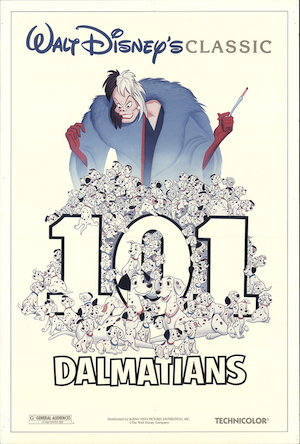 ONE HUNDRED AND ONE DALMATIANS (as it was spelled when it originally arrived in 1961) holds a unique place in the company’s history. Like THE LITTLE MERMAID, it was a success that came after a time of turmoil. The beautiful (but somewhat dull) SLEEPING BEAUTY had been an expensive financial disappointment, and there was talk of closing down the animation studio. They decided instead to try making a movie where they Xerox the animators’ pencil drawings directly onto cels, an Ub-Iwerks-invented process they’d used for a scene in SLEEPING BEAUTY. By eliminating the step of inking they lowered production costs immensely, and also made it more possible to animate the important detail of the dogs’ many spots.
ONE HUNDRED AND ONE DALMATIANS (as it was spelled when it originally arrived in 1961) holds a unique place in the company’s history. Like THE LITTLE MERMAID, it was a success that came after a time of turmoil. The beautiful (but somewhat dull) SLEEPING BEAUTY had been an expensive financial disappointment, and there was talk of closing down the animation studio. They decided instead to try making a movie where they Xerox the animators’ pencil drawings directly onto cels, an Ub-Iwerks-invented process they’d used for a scene in SLEEPING BEAUTY. By eliminating the step of inking they lowered production costs immensely, and also made it more possible to animate the important detail of the dogs’ many spots.
I think there are good and bad things about the Xeroxing. In general I prefer the clean crispness of ink lines. But in conjunction with DALMATIANS’ stylish backgrounds it really gives the movie a fresh, dare I say hip feel compared to previous Disney movies. And that’s appropriate for their first ever movie taking place in the then-present. I think there’s probly also something to be said for getting to see the animator’s actual lines. Sure, an inker might’ve perfected it, but sometimes the original drawing has an energy that just can’t be re-created.
(Walt Disney hated the look of the movie and didn’t want art director Ken Anderson to do any more, but acknowledged some kind of forgiveness shortly before his death in 1966.)
Another really innovative technical feat is the way they animated the vehicles. This is a 1961 movie with three-dimensional car shots comparable to ones made now with computer assistance. They did it by filming model cars with thick lines drawn onto the edges, Xeroxing the footage onto cels and painting over them. It looks great!
Usually when you see images from this it’s either Cruella or a bunch of dogs. So I wanted to share some screengrabs of the scenery to remind you how purdy this movie is:
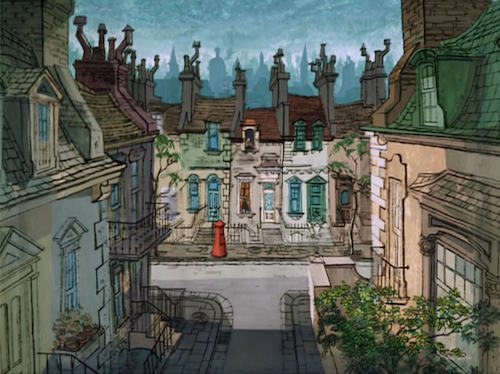
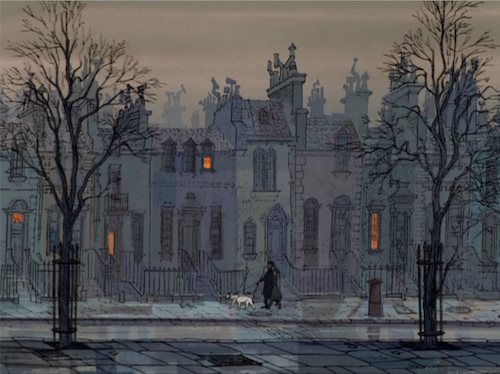
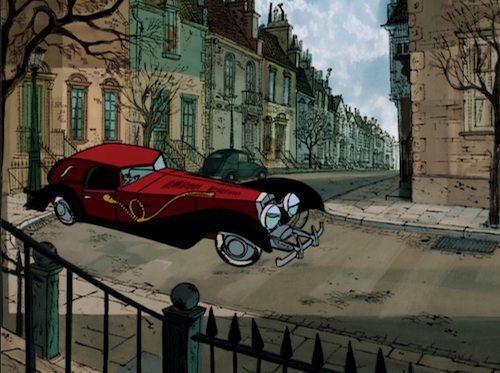
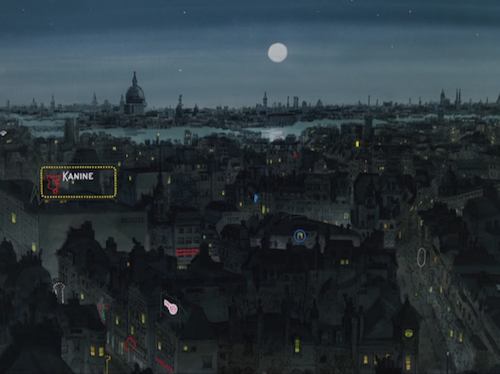
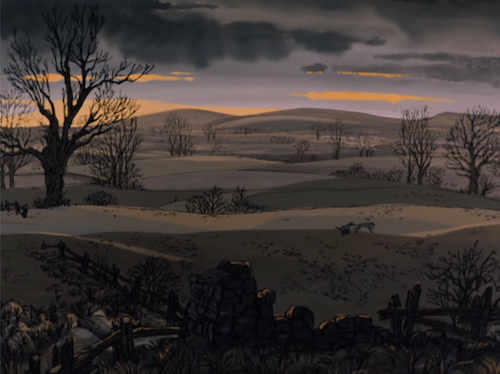
I can go on about how cool the movie looks, but not as long about the story, which is pretty simple. Honestly I had mostly forgotten, even though I’ve seen it a few times and am aware of the live action version and the live action version sequel and the DTV animated sequel and the animated TV series and the live action CRUELLA prequel. But, you know, a man and woman meet while walking their Dalmatians in the park. The humans, Roger and Anita, fall in love and get married, and their dogs Pongo and Perdita do too, and have 15 puppies.
Anita has an obnoxious “dearly devoted old schoolmate” named Cruella de Vil who comes over and annoys them, and gets mad when they won’t sell her the puppies. Months later two crooks hired by Cruella steal the puppies. Roger suspects what happened but can’t prove anything, so the canine community gets together to take care of this shit. They use The Twilight Bark – a system of barking the 411 and passing it on across the country – to put out an “all dog alert.” Basically an Amber Alert. The sheepdog Colonel and his cat friend Sgt. Tibbs hear the alert and put two and two together that they heard puppies barking at the old de Vil place. So word gets back to Pongo and Perdy, they make a trek to get there, find that there are actually 84 other Dalmatian puppies along with theirs and that they’re gonna get turned into coats, so they help them escape and try to get home, etc.
Of course the main thing we all remember is Cruella, one of the all time great Disney villains. She’s a monster because she’s up for skinning puppies, but also she’s got kind of a lovable GREY GARDENS meets drag queen vibe to her, with her two-tone hair, jagged cheekbones and giant, ridiculous fur coat constantly sliding down her heroin junkie lookin shoulders as she storms in saying, “Dahling, how are you!,” blowing putrid green smoke in Anita’s face, putting out a cigarette in a cupcake and running back out the door. She’s so evil that she reads about the tragic dognapping in the newspaper (while smoking and wearing a fur coat in bed) and laughs at how Roger looks in the picture. She was animated by Marc Davis, the genius who also designed the Haunted Mansion and Pirates of the Caribbean rides.
One thing about being a contemporary story is that for the first time Disney animators got to create a TV show within a Disney movie, as the puppies watch a western starring a dog named Thunder. There’s also a game show called Guess My Crime. And they got to animate animation-within-animation in the form of a dog food commercial. I like that they differentiate the animation on TV from the animation around it by doing it in a limited UPA sort of style.

A nice touch that makes this different from most Disney musicals is that the two songs are worked in via Roger being an out-of-work songwriter. He sings them at home, playing piano and sometimes trumpet. And the cleverest part is that the famous one, “Cruella de Vil,” is not sung in sincerity – Roger improvises it to get a rise out of Anita because Cruella has just shown up at the door. He dances around singing about the awfulness of their visitor and making faces at his wife to tease her. It’s the only weapon he has against Cruella, who thinks he’s a loser and makes fun of his dream of making music.
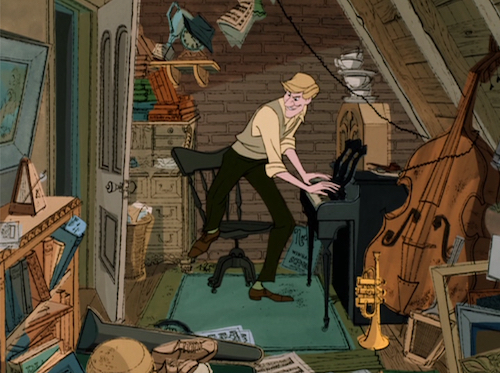
I kinda like smartass pipe-smoking jazz nerd Roger. I wonder if he ever considered getting an Aristocat instead of a dog? He’s got some pretty outdated attitudes though, the way he shakes Pongo’s paw while the puppies are being born in the other room, and says, “Why, you old rascal!” He’s just so proud of his dog’s insemination.
More blatantly sexist: the truck driver who almost gets run off the road by Cruella. Obviously he’s the victim in this scenario but still, “Crazy woman driver,” huh? Why did you feel it was important to specify the gender there, pal? Are you prepared to defend that choice? Good job winning that FURY ROAD type driving battle, though, leaving Cruella’s car in pieces. Respect.
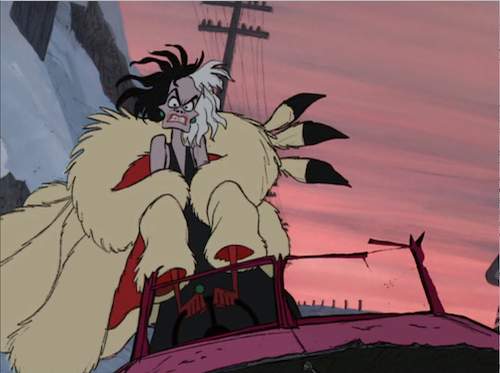

In the pre-DVD days of 1991 a reissue of a “WALT DISNEY’S CLASSIC” could sell alot of tickets. 101 DALMATIANS had already been re-released in 1969, 1979 and 1985. On this opening weekend of July 12th it came in #2 at the box office, below T2, but above the week’s other new releases, BOYZ N THE HOOD, POINT BREAK and REGARDING HENRY. It stayed in theaters for 24 weeks and made more than $60 million, surpassing SNOW WHITE AND THE SEVEN DWARFS [sic] as the biggest animated movie of all time, adjusted for inflation (before the summer it had been #6). An August 6 Baltimore Sun article declared, “She may not match the form-changing cyborg of Terminator 2: Judgment Day for pure evil, but Cruella, the villain of Disney’s 30-year-old 101 Dalmatians, is proving to be an astonishingly strong box-office draw this summer. 101 Dalmatians is, in fact, the biggest surprise hit of the season for Hollywood.”
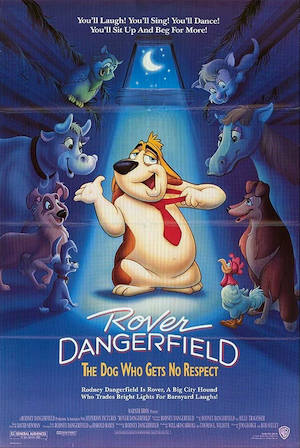 It was in week 3 – August 2, 1991 – that DALMATIANS faced competition from a brand new animated feature starring dogs. ROVER DANGERFIELD was distributed by Warner Brothers, and produced by Hyperion Animation, the studio behind THE BRAVE LITTLE TOASTER (1987), that most relatable story about a boy devastated by his family deciding they don’t need their old toaster.
It was in week 3 – August 2, 1991 – that DALMATIANS faced competition from a brand new animated feature starring dogs. ROVER DANGERFIELD was distributed by Warner Brothers, and produced by Hyperion Animation, the studio behind THE BRAVE LITTLE TOASTER (1987), that most relatable story about a boy devastated by his family deciding they don’t need their old toaster.
ROVER DANGERFIELD is the movie that dares to ask the question “What if Rodney Dangerfield was a dog instead of a human and therefore his name was Rover Dangerfield instead of Rodney Dangerfield?” According to Cartoon Research this incredible concept was devised by Harold Ramis (MEN’S GHOSTBUSTERS) around the time he wrote Dangerfield’s BACK TO SCHOOL. Ramis receives a co-“Story Developed By” credit, but sued Dangerfield because he allegedly wasn’t paid and because it says “Based On An Idea By RODNEY DANGERFIELD.”
If Ramis indeed came up with the idea that there should be a dog version of Rodney Dangerfield named Rover Dangerfield, then it is obviously his greatest creation and legacy, and that in itself makes it worth doing. But a man or woman should always be paid for their labor. I wonder if in retrospect Ramis wished he had never even told Rodney Dangerfield that he should do a movie called ROVER DANGERFIELD. He could’ve reworked the idea to do without him. In a way that would be an even stronger premise: what if a dog wasn’t Rodney Dangerfield?
I want to be clear about Rover Dangerfield here. Rover Dangerfield is not Rodney Dangerfield’s dog, or a dog that happens to be similar to Rodney Dangerfield in a world where Rodney Dangerfield exists. As far as we know, there is no Rodney in this plane of existence. Only Rover. But it’s also not like ROCK-A-DOODLE, where live action humans exist in one world but animated farm animals live in another one where animals have cities and cars and stuff. This is a world ruled by humans.
After a zoom through a digitally assisted three-dimensional desert landscape (very much like the opening of THE RESCUERS DOWN UNDER) the movie opens with the same gag as DALMATIANS: our lead character is narrating, and we look at a human as if that’s whose voice we’re hearing, but then it pans down to the dog. As if we were gonna believe this guy talked like Rodney Dangerfield!
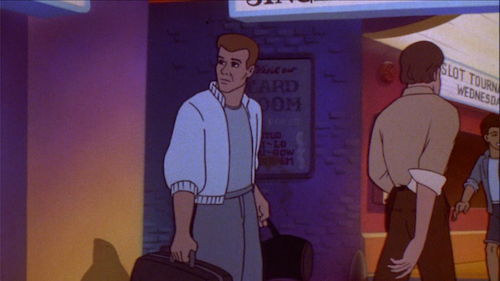
Rover is in an alley with the strays playing dice for bones and hitting on two pink poodles in pearl necklaces. He actually makes fun of a Dalmatian who opts out of the game. “Hey, stick around! We’ll play connect the dots!”
Dangerfield is credited as sole screenwriter. It definitely seems like he wrote all the wisecracks, but the story about him getting stranded on a farm and falling in love seems like standard cartoon bullshit. This could be a matter of Dangerfield just trying to write what he figures you’re supposed to for a cartoon, or of normal cartoon hacks rewriting it in storyboards. Part of the mystery of the movie is that, at least according to this Film School Rejects article, it was originally announced as an R-rated film to be released in 1988, when BACK TO SCHOOL was still fresh in people’s memories. By the time it came out 3 years later it was rated G.
It definitely wouldn’t get that today! Rover lives in Las Vegas, he walks around in casinos, his owner is a showgirl named Connie (Shawn Southwick, MONACO FOREVER) who he visits in a dressing room surrounded by her partially clothed co-workers (who all look like the Little Mermaid’s sisters).
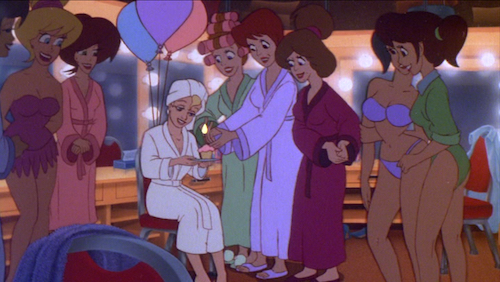
Rover hates Connie’s chain-smoking boyfriend Rocky (Sal Landi, BACK TO BACK), who he implies is a drunk and who seems like it when he stumbles in after forgetting her birthday. His design and archaic style of macho swagger would fit right into a Ralph Bakshi movie.
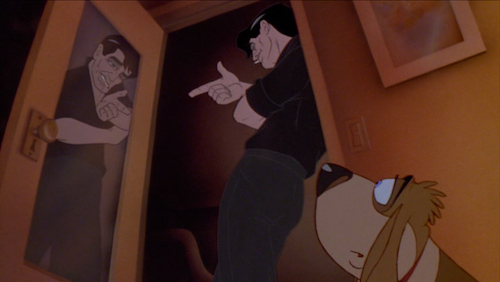
Although Rocky can’t hear Rover’s voice and doesn’t know he has human-like feelings he does feud with him. Rocky was trying to do some sort of deal with gangsters when Rover looked into a skylight and spooked them. So he puts Rover in a bag and throws him off the Hoover Dam.
So it’s crazy that it’s rated G, and it’s unclear who the audience is supposed to be, but I don’t get the impression it was produced as an adult movie and then cut. Except maybe in the part where Rover wakes up wearing sunglasses and it implies a night of drinking and/or drugs that we never saw. “Ooh, what a night. Boy, I’ll never do that again,” he says, before hallucinating ripples on the tiled floor and almost throwing up.
Anyway, some fishermen find him still alive in that bag and they bring him back to their farm (location unclear, but they “drove all night” to get there). In their truck they’re listening to “Respect” by Aretha Franklin because, do you get it, he don’t get no respect.
Most of the movie is on the farm, and is less weird, more normal cartoon animal business. Rover is loved by a towheaded, bulbous-Converse-wearing farm boy named Danny (Dana Hill, NATIONAL LAMPOON’S EUROPEAN VACATION), meets various farm animals, is scared by wolves, is not into playing fetch, tries out being a sheepdog. One part that makes it a very hard G movie is when the wolves kill the rooster (an actual character!) and Rover plays with the body pretending he’s still alive and then gets dragged into the woods to be shot. The gun is loaded and pointed at him but he’s saved when the wolves try to maul Danny’s dad.
By the way, there are songs – five of them! – written and sung by Dangerfield. When Rover meets his dream dog Daisy (Susan Boyd, later in THE MASK) he sings a little song about “I’d give up a bone for you!” And there’s a whole number about how he’s not gonna pee on a Christmas tree. (It’s called “I’ll Never Do It On a Christmas Tree.”) But also there’s a very sincere ballad where he looks up at the sky singing about FOMO: “Somewhere there’s a good time, I tell you it’s not fair, somewhere there’s a party, oh how I wish I was there.”
There is some clear overlap here with DOC HOLLYWOOD – the city dog who comes to the farm, falls in love, goes back home, feels empty, decides to come back. I don’t have a problem admitting that it’s a worse movie than DOC HOLLYWOOD, but is it stupid to say they handle that theme with a little more nuance? Yeah, probly. But I like that they acknowledge that yes, there are nice things about living on the farm, but also his city (Sin City!) is fun and it makes sense to miss it and Connie. When he comes back it’s because he realizes he’ll be happier with Daisy, not because he’s rejecting or disavowing Las Vegas life.
As in DALMATIANS and so many other animal movies, the conceit is that we hear the animals speaking English and sometimes see them standing upright or doing other human-like things, but the humans in the story can’t understand them and just see them as ordinary animals. A small, subtle addition to this is that Rover wears (and tugs on) a tie just like Rodney, but when the fishing guys find him in the water they look at the tie and say his name is Rover. So to humans it must just be a collar.
An insignificant thing this has in common with DALMATIANS is scenes of a dog watching TV. In this case you can’t really make out the screen but you can hear the sound from Daffy Duck cartoons.
The animation is a mixed bag. They’re definitely trying – there are shots with camera rotations and stuff. The humans are pretty detailed. It’s smoother and more sophisticated than a TV cartoon. But it doesn’t have an overall appealing aesthetic and – as there were likely many newcomers learning on the job – quality varies from scene to scene. Connie and Rocky are often well animated, and there’s a shot where the animator didn’t care about context, because he or she gives Connie and Rocky a passionate kiss like the cover of a romance novel even though we’re supposed to adore sweetheart Connie and wonder what she sees in this shitbag who she clearly adores here.
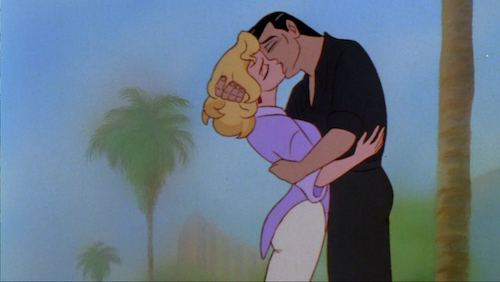
I do not think this is a good movie, but there are two things that made it watchable. One is just my fascination with the unanswerable question of what they were going for and how they ended up with this. And the second is that I do think he has some pretty funny lines, like telling a sheepdog “Eh, what’re ya workin so hard for? It don’t mean nothin. Let me tell you somethin. It’s who you know!” Or taunting the wolves with various three little pigs and Little Red Riding Hood references. Hearing Dangerfield’s voice telling Dangerfield jokes is a redeeming quality. But pretending we should be moved by a Rodney Dangerfield dog falling in love with a collie is a little much.
Anyway, the most important thing is that when he comes back he goes into the barn and there are a bunch of puppies that each look exactly like him or Daisy. So I think we should all be thankful this wasn’t R-rated so we didn’t have to see Rover Dangerfield fuck.
There are two credited directors, both of whom also did storyboards, character designs and character animation. Jim George had been an effects animator on Disney’s THE RESCUERS and Bluth’s Banjo the Woodpile Cat. After this he returned to Disney as a character designer for BEAUTY AND THE BEAST, and then did the same for, uh, FOODFIGHT!. The other director, Bob Seeley, has no credits before this and his only other directing is for some TV thing called Channel Umptee-3.
I said earlier that ROVER DANGERFIELD was competition for the re-release of 101 DALMATIANS. That was a huge exaggeration. I actually couldn’t find any box office information for it, but it didn’t make it into the top 12 on its opening weekend, so I don’t think it was released nation wide. That Film School Rejects article quotes Dangerfield’s autobiography, where he wrote, “I thought it was a funny movie, but I had some trouble with the studio, and they buried it like a bone.”
Dangerfield’s next movie was LADYBUGS, a family film that was actually seen by some people. And after that it was NATURAL BORN KILLERS, in one of the parts I liked. He returned to animation voicing for a cameo in CASPER, two episodes of The Simpsons, a Dr. Katz, Professional Therapist and a Nickelodeon movie called THE ELECTRIC PIPER. And he voiced a live action animal, “Bandit the Rabbit,” in RUSTY: A DOG’S TALE.
One of the character animators, Jeff Smith, started publishing his independent comic book Bone that year. It ran until 2004, a cult phenomenon that has repeatedly almost been made into a series or movie. (Based on his drawing style I suspect he did some of those Connie and Rocky shots, but that’s pure speculation.)
In 1992 Hyperion released a better-received comedian-based animated feature, BEBE’S KIDS, based on the routines by the late Robin Harris.


























August 12th, 2021 at 11:18 am
no kidding ROVER DANGERFIELD is the movie that Jeff Smith famously quit animation for to make BONE? I’d always wondered if it was just distaste with animation in general or a specific project that made him say, “ah, enough of this shit.”